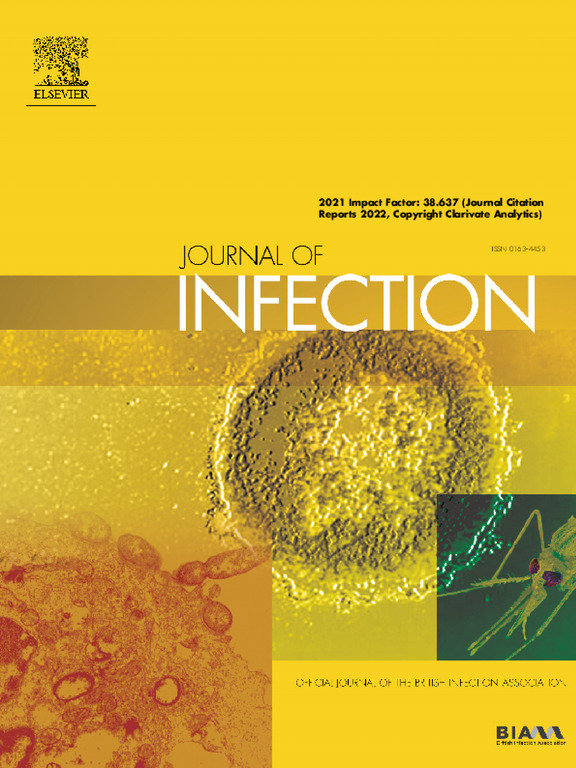在PCV13时代,流感嗜血杆菌仍然是澳大利亚接受通气管插入的儿童中主要的中耳炎病原体。
IF 14.3
1区 医学
Q1 INFECTIOUS DISEASES
引用次数: 0
摘要
前言:了解细菌携带模式和中耳炎(OM)微生物学对评估疫苗影响和为政策提供信息至关重要。OM的微生物学可随地理、时间和肺炎球菌结合疫苗(PCVs)等干预措施而变化。在引入PCV13 11年后,我们评估了生活在西澳大利亚州的儿童鼻咽和中耳积液的微生物学。方法:招募因复发性急性OM和/或慢性OM伴有积液而接受手术的儿童(病例)和因非感染性原因接受手术的儿童(对照组)。收集鼻咽拭子和中耳积液(仅限MEE病例),应用定量PCR检测流感嗜血杆菌、卡他莫拉菌、肺炎链球菌、铜绿假单胞菌、金黄色葡萄球菌和化脓性链球菌。培养肺炎链球菌阳性MEE血清分型。结果:从2022年9月至2023年12月收集了166例5岁以下儿童的鼻咽拭子(123例,对照组43例)和103例MEE(93例双侧积液- 196例MEE样本)。与对照组相比,鼻咽携带流感嗜血杆菌的病例更常见,密度高10倍(84.2%的流感嗜血杆菌携带阳性病例比48.9%的对照组,p=0.024;平均DNA浓度分别为1.8pg/µL和0.13pg/µL, p=0.037)。肺炎链球菌在病例中更常被携带(无统计学意义),与对照组相比,病例的携带密度更高(平均肺炎球菌DNA浓度为0.4pg/µL对0.09pg/µL, p=0.049)。病例与对照组卡他黑毛杆菌携带量及携带密度相似(82.1%对76.7%)。携带2种或2种以上耳病原菌是常见的(80%的拭子)。在MEE中,以流感嗜血杆菌为主(pcr阳性53%),其次是卡他菌(31%)、肺炎链球菌(22%)、金黄色葡萄球菌(6%)、化脓性葡萄球菌(2%)和铜绿假单胞菌(2%)。26%的积液存在多微生物感染。在肺炎链球菌pcr阳性MEE中,来自11名儿童的14份标本可培养,血清型均为非pcv13型。结论:儿童复发性和/或慢性OM的病因主要与流感嗜血杆菌有关。这些数据突出表明,需要采取协调一致的努力,制定有效的流感嗜血杆菌预防战略,特别是不可分型(NTHi)。高价pcv可能影响肺炎球菌OM。本文章由计算机程序翻译,如有差异,请以英文原文为准。
Haemophilus influenzae remains the predominant otitis media pathogen in Australian children undergoing ventilation tube insertion in the PCV13 era
Introduction
Understanding patterns of bacterial carriage and otitis media (OM) microbiology is crucial for assessing vaccine impact and informing policy. The microbiology of OM can vary with geography, time, and interventions like pneumococcal conjugate vaccines (PCVs). We evaluated the microbiology of nasopharyngeal and middle ear effusions in children living in Western Australia, 11 years following the introduction of PCV13.
Methods
Children undergoing surgery for recurrent acute OM and/or chronic OM with effusion (cases), and children undergoing surgery for non-infectious reasons (controls), were recruited. Nasopharyngeal swabs and middle ear effusions (MEE - cases only) were collected, and quantitative PCR applied for detection of Haemophilus influenzae, Moraxella catarrhalis, Streptococcus pneumoniae, Pseudomonas aeruginosa, Staphylococcus aureus and Streptococcus pyogenes. S. pneumoniae-positive MEE were serotyped by culture.
Results
Nasopharyngeal swabs from 166 children under 5 years of age (123 cases, 43 controls) and MEE from 103 cases (93 with bilateral effusion – 196 MEE samples) were collected between September 2022 to December 2023. Nasopharyngeal carriage of H. influenzae was more common and density 10 times higher in cases compared to controls (84.2% H. influenzae carriage-positive cases versus 48.9% of controls, p=0.024; mean DNA concentration of 1.8 pg/µL versus 0.13 pg/µL, p=0.037). S. pneumoniae was more commonly carried in cases (not significant), and carriage density was higher in cases compared to controls (mean pneumococcal DNA concentration of 0.4 pg/µL versus 0.09 pg/µL, p=0.049). M. catarrhalis carriage and carriage density were similar between cases and controls (82.1% versus 76.7%). Carriage of 2 or more otopathogen species was common (80% of swabs).
In the MEE, H. influenzae predominated (53% PCR-positive) followed by M. catarrhalis (31%), S. pneumoniae (22%), S. aureus (6%), S. pyogenes (2%) and P. aeruginosa (2%). Polymicrobial infection was identified in 26% of effusions. Of the S. pneumoniae PCR-positive MEE, 14 specimens from 11 children were culturable and all serotypes were non-PCV13 types.
Conclusion
The aetiology of recurrent and/or chronic OM in children continues to be primarily associated with H. influenzae. These data highlight the need for a concerted effort to develop effective preventative strategies for H. influenzae, most notably, nontypeable (NTHi). Higher valency PCVs may impact on pneumococcal OM.
求助全文
通过发布文献求助,成功后即可免费获取论文全文。
去求助
来源期刊

Journal of Infection
医学-传染病学
CiteScore
45.90
自引率
3.20%
发文量
475
审稿时长
16 days
期刊介绍:
The Journal of Infection publishes original papers on all aspects of infection - clinical, microbiological and epidemiological. The Journal seeks to bring together knowledge from all specialties involved in infection research and clinical practice, and present the best work in the ever-changing field of infection.
Each issue brings you Editorials that describe current or controversial topics of interest, high quality Reviews to keep you in touch with the latest developments in specific fields of interest, an Epidemiology section reporting studies in the hospital and the general community, and a lively correspondence section.
 求助内容:
求助内容: 应助结果提醒方式:
应助结果提醒方式:


